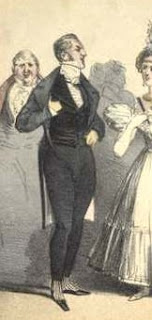Beau Brummell and the Wit of Wilde
So much is left to our imaginations upon invoking characters of the Regency era.
And intrigue is all the more intense in the case of George Bryan Brummell – arguable founder of Celebrity Culture.
It was 'Beau' Brummell (1778-1840) who led London fashion away from the pansy spectacle of bewigged fops. A non-nobleman who became 'Arbiter Elegantiarum' (essentially, Fashion Dictator) as appointed by an enamoured Prince Regent.
Beau Brummell was ‘famous for being famous’ and a precursor to the youthful course of Oscar Wilde (1854-1900).
And yet the latter lived a life of bon mots that thrive to this day. Whereas attempts to capture the droll hilarity of Brummell’s sayings have always escaped epigram.
The fashionista’s abstract jests, observed a contemporary:
“turn upon a single circumstance, the exaggerating of the merest trifles into matters of importance, or treating everything else with the utmost nonchalance and indifference.” (1)
If you’re beginning to sense the essence of Wildean Wit, it’s not without acknowledgment.
Wilde's 1893 play 'Lady Windemere's Fan' contains a homage to the humour of Brummell. The title stems from a particular incident that amused Wilde. However, like most of Brummell's pithy put-downs; it requires context to animate "the twinkle of manner that only occasionally married itself with verbal wit as fits the page." (2)
The scene went something like this…
A traveller had returned from the north of England to recount his trip to Brummell one bleary morning. The Beau would spend several hours being dressed to perfection by his valet, Robinson, before ever being seen in public.
Cravat creases were of paramount importance for studied carelessness to appear natural among many other points of style.
And all the while this lingering guest enthused over the Lake District.
Eventually, Brummell was asked which of the lakes was his favourite. He paused, and passed the question to his valet:
"Robinson."
"Sir."
"Which of the lakes do I admire?"
"Windemere, sir," replied that distinguished individual.
"Ah yes, – Windemere," repeated Brummell, "so it is, – Windemere." (3)
Hardly as neat a rejoinder as say, “It is absurd to divide people into good or bad. People are either charming or tedious.” Although Wilde makes the precise same point in his capricious play.
In a sense, Beau Brummell was the more subtle wit. In that his genius was entirely:
'... reflected in his words, his acts, his attitude, his gestures and in the very sound of his voice.' (4)
Jules Barbey d’Aurevilly and Charles Baudelaire (5) duly devised an intellectual formula for dandyism that Wilde doubtless studied, integrated and perfected. The French essayists revealed dandyism exists in every era: and that demeanor is as much a defining element as dress sense.
Whilst Brummell’s “impertinence was too thorough-going to be condensed and contained in epigrams alone” (6) – Wilde enabled the concept to enter the realm of quotation.
So next time you’re at a performance of a Wilde work that relies on dandies to reveal the irony, look again. Beyond the actors’ airs and drawls, for the legacy of Beau Brummell, whose:
“… effect on people was more immediate than any produced by language alone. He produced it by an intonation, a look, a gesture, by deliberate intention, even by silence…” (7)
Qualities so easily lost to time yet preserved to amuse for all time!
For my comprehensive look at Brummell’s reputation as a Regency wit: 'Who's your fat friend?' - the impudent humour of Beau Brummell - Wattpad
REFERENCES
1) Brummelliana by William Hazlitt (1828)
2) Beau Brummell – the Ultimate Dandy by Ian Kelly (Hodder & Stoughton Ltd., 2005) p7
3) The Life of George Brummell Esq., Commonly Called Beau Brummell by William Jesse (Saunders & Otley 1844), vol. 1, p118
4) On Dandyism and George Brummell – an 1845 essay by d’Aurevilly, reprinted in George Walden’s Who’s a Dandy? (Gibson Square Books, 2002) p115
5) See Baudelaire’s essay The Painter of Modern Life (1863)
6) Walden, p114
7) ibid p116






Comments
Post a Comment